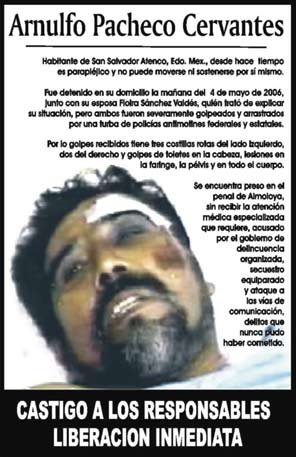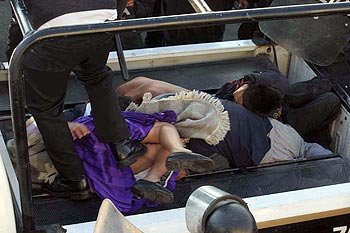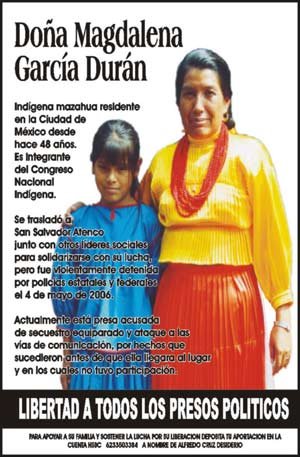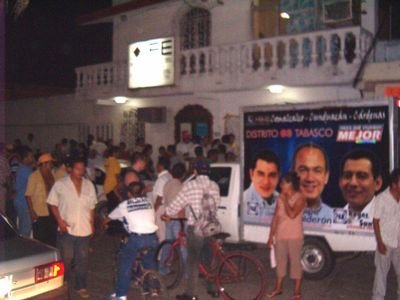


In Mexico, a Month Later, the Police Brutality in Atenco is Covered Up with Newer Violations of Human Rights
Political Prisoners, Many Still Gravely Wounded, Are Held Incommunicado and Without Access to Doctors, Family Members or Human Rights Investigators
By Al Giordano
The Other Journalism with the Other Campaign in Mexico
June 3, 2006
Imagine Mexican President Vicente Fox, on the telephone with his foreign political consultants, seeking advice on how to do “damage control” on the public relations disaster that began a month ago in the towns of Texcoco and Atenco and just keeps growing. “Hey, Dick Morris, when I went to Los Angeles and Seattle they accused me of being a rapist.” Or, “hey, Rob Allyn, I went to Chiapas and an angry multitude surrounded the restaurant and ruined my lunch with the governor.” This is a man so eager to change the subject from Atenco that, on his way home from California last month, he mistakenly claimed to reporters on his airplane that a vote in the U.S. Senate on a dubious immigration reform bill meant passage of a law and a victory for his administration… even though the measure still had to go to the House of Representatives – where its chances are nil – and where it languishes still. When he realized his error he bolted from the press cabin, scowling, and cut short the press conference.
Fox clearly isn’t bothered by the human side of the problem on the Mexican side of the border: the illegal arrests, warrantless searches, savage beatings, sexual tortures and rapes that federal and state police inflicted on May 3 and 4. (Is it any wonder that so many Mexicans – living under a government like this one – head North?) For Fox and his gang it is a political problem: All that firepower and muscle sent to round up the dissidents and still the State failed to silence those who dared to say that Mexico is governed by an illegitimate authoritarian regime. Day after day, every new fact that emerges proves that Fox and others who say Mexico has transitioned to “democracy” with “human rights” are lying cynically from the same script that defined the seventy years prior of one-party rule.
A politician, at a time like this, asks his consultants how to spin the story. And the advice is always the same: try to change the subject, and if there is bad news, hush it up.
Here are some examples of what Fox would consider “bad news” from a PR perspective, and what his government has done to hide it, even though doing so has brought, again and again, for thirty days and thirty nights, more “bad news” both for the victims and the victimizers.
Arnulfo Pacheco Cervantes: Paraplegic in Prison
Hermann Bellinghausen reports in La Jornada:
Arnulfo Pacheco Cervantes is, almost one month after the police raid against the population of San Salvador Atenco, the living proof that human rights don’t matter to the authorities. Beaten brutally (five broken ribs, and large sores all over his body), he is in the Santiaguito prison accused of “felony” crimes: “kidnapping” and “attacking public roads.” The most notable fact is that Pacheco Cervantes, beyond his old age, has been half-paralyzed since prior to his arrest, and he can barely talk. A person in his condition can’t even cross the street, much less “attack” it. With the goal of apprehending this dangerous subject, the state police raided his home in Atenco on May 4, and dragged him from the bed where he was laying, while they battered him and dragged him across the floor to the bus where they threw him like a sack and brought him here to the prison.His wife, Floira Sánchez Valdez, who tried to explain to the agents the clinical condition of her husband, was also beaten and arrested. Today, don Arnulfo is behind bars without medical attention, with three broken ribs on the right and two broken ribs on the left; with traumatic wounds on his head, pharynx and pelvis, and he can’t talk. He needs urgent hospitalization. After one month in these conditions, the prison authorities have offered him only paracetamol pills. Nothing more. And they don’t allow a doctor from outside of the prison to see him, much less attend to him.
 |
Magdalena García Durán: Fox Tried to Buy Her
 Photo: D.R. 2006 Ratón Maicero |
García Durán, though, is not just any prisoner. She is an articulate social fighter and very active adherent to the Zapatista Other Campaign. On April 29 she went to the National Workers’ Gathering in Mexico City and proposed that, at the then upcoming May Day workers’ rally, that someone from the sector of indigenous workers be given the microphone. The assembly decided to invite her to give that speech. On May 1, in front of the National Palace, García told tens of thousands: “If they are going to kill us with hunger, better we die for something worthwhile.”
 Photo: D.R. 2006 Enlace Zapatista |
She later described what happened to her upon arrest to human rights investigators at the Comite Cerezo:
On arriving at the van the first thing that the riot police did was to pull hard on the chains, spin me around and force me down, bending my head and covering it with an overcoat while the other riot police kicked me. We walked a great distance. We arrived at a small pick-up truck and they threw me like sack on top of the others that came, I did not fall well, so they punched me, I felt as if I was drowning because they were throwing more and more people on top of us and they were very heavy. The van was delayed there for quite a while later it started towards a truck, on arriving at the truck again I was forced with my head down to climb into the truck. They shouted at me, insulted me, hurried me, wanted me to walk on top of the people that were already piled up but as I could not do it, two riot police hauled me by my plaits, began to ask my age and insulted me telling me that I was such a “horrible old woman to walk in this chaos” that they were going to kill me like dog and they threatened to cut off my head. They repeated that threat many times. They dragged me by my hair over all the people to carry me to the rear door of the truck. I realized that there were many people injured and bleeding. It was terrible. I was asking that they remove the people on top because they felt that they were going to die. Then when we arrived at the prison they put me down with my head bowed, because the media were present and they did not want them to see the faces. On entering the prison they began to question me, they took my cell-phone off me and they threw it in the trash.
That testimony was taken on May 15, 11 days after her arrest.
The first time Magdalena was heard from after she was essentially kidnapped by the State was six days afterwards, on May 10 – Mother’s Day in Mexico – when she was brought to her arraignment along with other political prisoners, crowded together in a caged holding pen. Through a mesh fence and a hole in a fiberglass window she spoke to reporters, including a correspondent for Prensa India, who shared with us his videotape of the moment. García Durán explained:
“I am a Mazahua woman who has truly felt years of a life of extreme poverty, as a street vendor… And right now since I don’t have any money to pay and I have nothing to defend myself against an accusation of a crime I didn’t commit… I have to sell my mule named Filemón to be able to save myself from the damn government… I don’t like it that they repress us this way… First they beat us and now they frame us.”
Magdalena’s arrest has caused a particularly difficult public relations problem for the Fox government. She’s a recognized indigenous leader. Others from her Mazahua ethnic group immediately set up an encampment outside the prison and began, 29 days ago, a hunger strike for her release. The problem for the government is that once she does win release, she is somebody with an organization, a high public profile, and a way of talking and connecting with the people who will be able to tell the true story of what happened – the beatings, the sexual tortures, the rapes – with a coherency that will further demonstrate, far and wide, that the Mexican state is authoritarian and illegitimate.
So, what did Vicente Fox try to do about this problem? He tried to buy Magdalena García. So worried was he about the inevitable moment when Magdalena leaves prison and begins to tell her story as only she can tell it, Fox dispatched no less than a member of his presidential cabinet, Indigenous Affairs Secretary Xochitl Gálvez on a secret mission to the prison. Gálvez, to avoid being seen by the press, slipped into the penitentiary at 10 p.m. on a Saturday night (not exactly “visiting hours,” but, in any case, these political prisoners aren’t allowed visits from immediate family or doctors, just from, apparently, federal cabinet secretaries), May 19, to speak with political prisoner Magdalena García.
According to La Jornada, Gálvez offered to provide her with a lawyer for her defense.
“Magdalena told her ‘no,’ that she didn’t believe that the Fox government was acting in good faith in offering her a hand after arbitrarily arresting her and beating her unconscious. ‘I already have someone to defend me. I don’t need you.’”
 |
In any case, our compañeros over at Ce-actl and the Indigenous National Congress, who made the poster with the photo of the brutalized paraplegic Arnulfo Pacheco, also made one of the dignified face of Magdalena García Durán, that appears alongside this text. One more, click the graphic for a larger version, print it, copy it, distribute it widely for the compañera who holds the keys to her own cell – if she would just sell her soul to Vicente Fox’s human rights violating cabinet secretary – but who, when confronted with two paths out of prison, chose the one below and to the left.
A Deeper Tomb for Nacho and “the Leaders”
Most of the 217 people arrested on May 3 and 4 were brought to a state prison known as Santiaguito, where, despite all the best efforts by authorities to keep them silenced and incommunicado, and to keep them under lock and key until their visible wounds (and the gynecological and proctologic evidence of rape) disappeared, the undertow of real facts has already led to 17 being freed due to total lack of evidence and another 172 released on $1,400 dollar bond while awaiting non-felony charges (mainly “attack on public roads” which, supposedly, these folks did from inside of the family homes where they were arrested.)
 Photo: D.R. 2006 Alfredo Domínguez, La Jornada |
Not a single family member, doctor nor human rights investigator has been allowed to visit either of these three compañeros in La Palma. On June 1, representatives of the European Association of Democratic Attorneys and the International Civil Commission of Human Rights Observation tried to visit the men. They were denied entrance.
The judicial proceedings (arraignment, discovery hearings, etcetera) regarding the charges against these men have been held in a Star Chamber; behind closed doors with no press access. “Mexican law and international treaties insist that such hearings must be public,” Spanish attorney Jaime Azens told La Jornada. “But as we have observed, these are secret trials and that represents a serious violation.”
Last Saturday, according to the same report, José Alvarez, brother of the political prisoner Felipe, went to the federal prison with all the paperwork required to visit his immediate family member. The authorities’ excuse to deny him entry: He had a hole in one of his socks.
What’s more: the Mexican Armed Forces have set up a roadblock on the road to La Palma, stopping and searching any and all who try to visit or draw near. So while Vicente Fox and his functionaries claim to be investigating the police abuses of human rights, federal fingerprints can be found on the fear campaign to keep anyone from seeing or visiting these men. At the gates of the prison: a riot squad of the Federal Preventative Police, outnumbering any small group of people that tries to find out what is happening there with these prisoners.
A report was broadcast tonight among alternative media organizations: two more political prisoners from Atenco – Arturo Sánchez Romero and María Patricia Romero Hernandez – are scheduled to be transferred to the federal lock-up at La Palma late tonight.
None of this is normal, even by Mexican authoritarian standards. As Hermann Bellinghausen observed on Thursday:
“This reporter witnessed yesterday the transfer of ‘six dangerous kidnappers’ from Santiago prison to another prison. Each one was brought in a different patrol car (good cars, in any case), guarded by four agents. Their clothes were impeccably clean. They were recently bathed. They even smiled. A dangerous gang, say the Judicial Police. While handcuffing one of them, the agent asked gently, “is it too tight?” No, it wasn’t too tight, was the response. And they brought them in a small convoy towards Toluca.”
In a land where kidnappers, narcos, corrupt politicians, and other prisoners receive, generally, a kind of elite treatment while imprisoned, something very different and haunting is happening to Nacho del Valle, to Hector Galindo, to Felipe Alvarez and, tonight, apparently, to Arturo Sánchez and to Maria Patricia Romero. A month after their arrests they are hidden from public view, from access to doctors, to human rights observers, denied visits by family members.
So, what is really happening to these political prisoners?
To understand what the Mexican State of Vicente Fox is doing to these men – and soon to be one woman – one needs to understand: La Palma is the new Lecumberri. And what was Lecumberri? It was known as the Black Palace. From 1900 to 1976, political prisoners were brought to the Black Palace in Mexico City to be tortured by every technique known to Pentagon manuals; electric shocks, drowning, rape, sexual torture, torture of one inmate in front of another… Read the Wikipedia entry on Lecumberri:
“Throughout its 76-year tenure as a prison, only two people ever escaped alive. The first, Pancho Villa, was a general of the Mexican Revolution. The second was Dwight Worker, an American convicted of smuggling cocaine. With the aid of his then-wife, Worker escaped on December 17th, 1975 disguised as a woman. They later authored a book about their experiences entitled Escape (ISBN 0-913374-76-8).”
“They’d wrap me in cloth like a mummy, tie me to a plank and dunk me in a tub of water until I’d almost drown,” said one former inmate of Lecumberri.
In another case:
“…an unidentified woman is reported describing how six secret police officers kidnapped her husband, raped her, forced her to watch as they inflicted electric shocks on her 14-month-old daughter and taunted her, saying: ‘You’ll beg us to kill you.’”
Now that the Mexican government of Vicente Fox, guided by U.S. political consultants Dick Morris and Rob Allyn, has opted to return to the violent tactics of the 1960s and 1970s in this country, is it a stretch to consider the possibility – no, probability – that the same torture tactics are being deployed today against Nacho del Valle and the other compañeros in Atenco?
The burden of proof is on the State. Until Nacho, Arnulfo, Magdalena and the others walk freely in the open air and can speak of their stories, presume the worst. But one thing is for certain: If not for the Other Campaign, and the noise that is being made nationally and internationally for their freedom, these friends and neighbors would already be disappeared, never to be heard from again.
And that still might happen, if good people do nothing in this time of moral crisis.
Click here for more Narco News coverage of Mexico
Lea Ud. el Artículo en Español
- The Fund for Authentic Journalism
For more Narco News, click here.




